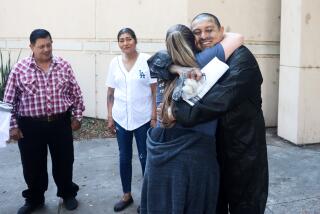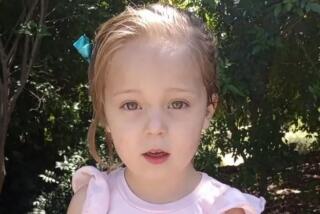Return of Tot to Parents Was Urged, Official Says
The director of Ventura County’s social services agency says his department recommended returning a 2-year-old Oxnard tot to her parents the month before she was battered to death in June.
Also, James E. Isom said Saturday that the Protective Services Division’s policies for returning children to their parents will be reviewed this week in the wake of the death.
Isom made the comments amid lingering questions over the June 22 beating death of Joselyn Hernandez. The toddler died of what the county coroner described as blows to the stomach a few weeks after being returned to her parents. No arrests have been made in the case.
Officials had removed Joselyn from her home two years ago, when she was reportedly hospitalized six weeks after her birth with broken legs, cracked ribs, bruised lungs and week-old burns to her hands and feet. After medical treatment, she was placed in protective custody and released to her grandmother.
But the grandmother died and the parents, Rogelio Hernandez and Gabriela Nieto, both now 18, won custody of their daughter in May.
While Ventura County Superior Court Judge Lawrence Storch reportedly told colleagues that all parties involved had recommended returning the child to her parents, sources recently said case workers had objected. Isom now says those reports were untrue.
“What happened is, we recommended the child be returned home,” Isom said. “The information that was released by us said just the opposite, so that it put the judge in a position--it put him in a very bad position--that sounded like the judge was ignoring the social workers’ professional opinion and all of that, when the judge did exactly what we asked him to do and that was release the child.”
Isom said he did not know who leaked the incorrect information.
The child was returned home permanently after a 60-day visit and the mother and father completed parenting classes. In addition, various programs are routinely ordered by the courts to monitor the family, but Isom said he did not know exactly what was proscribed in this instance.
Isom, who has headed the social services agency for 21 years, said the 130-employee Protective Services Division will “tear apart” its policies and regulations relating to emergency response, family unification and follow-up evaluations this week.
“We need to make sure we aren’t leaving any holes in our service delivery system where children can get hurt,” he said. “I’m not ready to say we had a problem with the way this case was handled.”
But Isom said he also questions whether the system failed to protect Joselyn. The short answer, he said, is that he doesn’t know.
The social worker made the recommendation to return Joselyn to her parents after the child was examined upon her return from a trip to Mexico for her grandmother’s funeral. The decision was made despite a “small, old bruise” on the child’s cheek and a burn on her hand reportedly caused by hot water, Isom said.
“Even after seeing those injuries, the social worker felt the best interest of the child would be to return her to her natural parents rather than relatives, to foster parents or put her up for adoption,” Isom said. “I support the workers’ decision because her job is not to keep the family separate, but to keep a family together.”
Despite system safeguards, he said, it’s impossible to watch suspected abused children 24 hours a day.
“I could not guarantee to you that if I hired 100 more staff tomorrow, something like this could not happen again,” he said. “There was nothing extraordinary about this case other than the child’s dead.”
More to Read
Sign up for Essential California
The most important California stories and recommendations in your inbox every morning.
You may occasionally receive promotional content from the Los Angeles Times.









